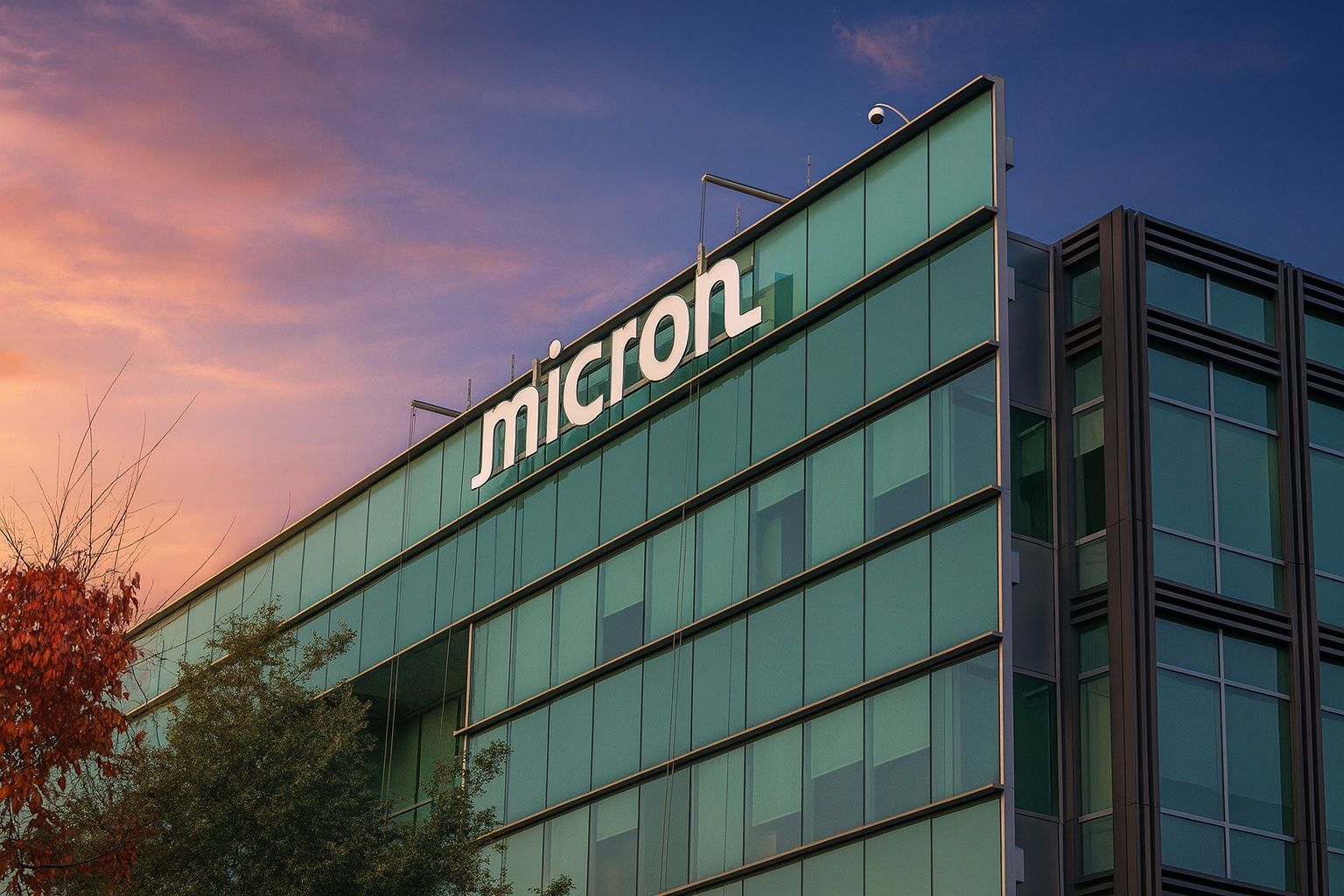- New Highs: Micron Technology’s share price hit an all-time high above $200 this week after surging 6% on Thursday, now more than doubling in 2025 amid a frenzied AI-driven rally [1].
- Record Results: The memory chip maker’s latest earnings shattered expectations. Fiscal Q4 2025 revenue jumped ~46% YoY to $11.32 billion with non-GAAP EPS of $3.03, easily topping forecasts [2]. Full-year revenue climbed 49% to $37.4 billion, as Micron swung to $8.5 billion in net income from a prior-year slump [3].
- Bullish Outlook: Management issued upbeat guidance for the current quarter (Q1 FY2026), projecting ~$12.5 billion in revenue and ~$3.7 EPS – far above Wall Street’s ~$11.9 B and $3.0 estimates – implying 35–40% YoY growth as AI chip demand shows no sign of cooling [4].
- AI Memory Boom: Explosive demand from artificial intelligence data centers is turbocharging Micron’s sales. Its high-bandwidth memory (HBM) chips – crucial for AI supercomputers – are effectively sold out (about $2 billion in Q4 HBM sales), while Micron’s cloud/server memory revenues soared +213% last quarter amid unprecedented orders [5].
- Street Optimism: Wall Street is overwhelmingly bullish on MU. Roughly 30 analysts rate it a Buy, and many have hiked price targets. Citi just raised its target to $240 and UBS to $245, while BNP Paribas is even more bullish at $270 – reflecting bets that Micron’s growth streak will continue [6] [7]. The average analyst price goal sits in the high-$190s, with a “Strong Buy” consensus [8].
- Valuation & Risks: Despite the rally, Micron’s valuation (≈20× forward earnings, PEG ~0.4) isn’t stretched given its growth [9]. However, memory is a notoriously cyclical business – some experts warn a lot of the good news may be “baked in” at current prices [10]. Investors face risks like volatile chip pricing, new supply coming from rivals, and geopolitical headwinds that could eventually cool this AI-fueled boom [11].
AI Boom Lifts Micron to Record Highs
Micron Technology (NASDAQ: MU) is on a tear as investors pile into AI-focused semiconductor stocks. Shares of Micron jumped about 5.5% on Thursday to $204+ intraday, notching a fresh 52-week high (recent peak $206.34) [12] [13]. Even on a down day for the broader market, Micron was among the top gainers in the S&P 500, boosted by bullish analyst calls [14] [15]. The stock has now more than doubled year-to-date, vastly outperforming the tech sector, after starting the year near multi-year lows. (Micron’s 52-week low was just $61.54 [16].) Its market capitalization has swelled to over $220 billion as of this week.
This meteoric rally is fueled by “AI mania” sweeping the chip industry [17]. Micron is seen as a critical “pick-and-shovel” play for the AI revolution – supplying the memory chips essential for training and running advanced AI models [18]. Every cutting-edge AI processor (like NVIDIA’s GPUs) requires vast amounts of high-speed memory, which Micron provides. As a result, Micron has been a prime beneficiary of the boom in artificial intelligence spending [19] [20]. Notably, industry peers have also soared: GPU leader NVIDIA hit record highs, and memory rivals Samsung Electronics and SK hynix saw their shares climb to all-time levels amid the upcycle [21]. Micron’s ~100%+ stock gain in 2025 actually outpaces many of these peers [22], underscoring its central role in the 2025 tech story.
There have been bouts of volatility along the way. After breaching $200 in early October, Micron briefly pulled back to the $180 range within days, amid broader market jitters and U.S.–China trade tensions [23]. That dip – and a quick rebound – highlighted the stock’s sensitivity to news flow. Overall, however, Micron’s momentum remains firmly bullish heading into late October, with trading volumes running high as buyers continue to snap up shares. The question now is whether Micron can sustain this momentum as it rides the AI wave to new heights.
Blowout Earnings Driven by AI Demand
Micron’s latest earnings report has validated the market’s enthusiasm. In late September, the company announced record-breaking fiscal Q4 2025 results that handily beat expectations. Revenue for the quarter jumped to $11.32 billion – a 46% year-over-year leap – while adjusted earnings hit $3.03 per share, topping analyst forecasts (~$11.1 B and $2.86) [24]. “Micron closed out a record-breaking fiscal year with exceptional Q4 performance, underscoring our leadership in technology, products, and operational execution,” CEO Sanjay Mehrotra said of the results [25]. For the full year FY2025, Micron’s sales climbed to $37.4 billion (up ~49% YoY) and GAAP earnings per share reached $7.59 – a dramatic turnaround from the prior year’s downturn [26].
The driving force behind Micron’s stunning rebound is unprecedented demand from AI and cloud computing. Data centers racing to train large AI models are clamoring for Micron’s memory chips, which are needed in enormous quantities. In particular, Micron’s advanced HBM (High Bandwidth Memory) chips – used alongside GPUs in AI supercomputers – are selling as fast as the company can make them. Micron reported nearly $2 billion in HBM revenue in Q4 alone [27]. These high-end chips (including Micron’s latest HBM3E modules) are effectively sold out through next year as AI customers secure supply. The company’s data-center/“Cloud Memory” segment saw sales skyrocket 213% year-on-year last quarter thanks to these AI-fueled orders [28].
This AI boom has not only lifted Micron’s revenue to new heights, but also its profitability. Many AI-oriented products carry premium pricing and fat margins. Micron’s non-GAAP gross margin hit about 45.7% in Q4, up sharply from ~36% a year ago [29]. In fact, Micron’s gross margins on an adjusted basis topped 50% for the first time since 2018 [30] – a remarkable recovery from the memory glut of 2022–23. The company’s focus on higher-value markets (like server DRAM, HBM, and automotive memory) and its exit from lower-end commodity products (e.g. smartphone flash memory) appear to be paying off [31]. Micron even cut roughly 300 jobs in its legacy mobile NAND division as it pivots to more lucrative segments [32]. All told, Micron has transformed from a struggling chipmaker a couple years ago into a high-growth leader today, thanks to insatiable AI-driven demand “clawing” for its memory chips [33].
Upbeat Guidance Sparks Buying Frenzy
Crucially, Micron’s management doesn’t see the momentum slowing. Alongside its Q4 results, the company issued bullish guidance for the upcoming quarter (fiscal Q1 2026) that blew past expectations. Micron forecast roughly $12.5 billion in revenue and around $3.70 in EPS for the quarter ending November – vastly higher than Wall Street’s prior estimates (~$11.9 B and $3.0). This outlook implies another 35–40% year-over-year increase in sales, and would mark Micron’s highest quarterly revenue ever if achieved [34]. Executives also indicated gross margins should expand above 50% on the back of strong pricing, signaling that the company’s AI-fueled growth spurt is still accelerating.
The street’s reaction was immediate: Micron’s stock jumped in after-hours trading when the guidance was released, and bullish sentiment has only grown since. “The latest guidance blew Wall Street’s expectations out of the water,” one analyst remarked, as Micron decisively outperformed even the most optimistic forecasts [35]. Analysts have been scrambling to raise their estimates and targets in response to Micron’s upbeat outlook. The company’s leadership sounded confident as well – CEO Mehrotra emphasized that Micron is entering the new fiscal year with its “most competitive portfolio to date” and is poised to capitalize further on the surging demand [36].
Analysts Hike Targets as AI Prospects Brighten
Wall Street is nearly unanimous in its bullish view of Micron. Dozens of analysts have a Buy or equivalent rating on the stock, reflecting Micron’s swift financial turnaround and promising growth runway. According to MarketBeat, 5 analysts currently call Micron a “Strong Buy,” 25 rate it “Buy,” and only 5 advise Hold – 30 out of 35 leaning positive [37]. The stock’s powerful rally in 2025 has actually pushed it slightly above the consensus price target (around $197 per share [38]), but instead of downgrading, many firms are simply raising their targets to catch up with Micron’s performance.
Just in the past week, multiple analysts boosted their projections significantly. For example, UBS upped its 12-month price objective from $225 to $245 and reiterated a Buy rating, citing “intensifying” memory chip shortages amid booming AI demand as a rationale for more upside [39]. Citi likewise lifted its target from $200 to $240, arguing Micron could be next in line to score a major supply deal with OpenAI (creator of ChatGPT) following recent AI partnership wins by Nvidia, AMD, and Broadcom [40]. KeyBanc and Morgan Stanley both bumped their targets into the low $200s range (around $215–$220) after the earnings beat [41]. And one of the most bullish calls came from BNP Paribas, which upgraded Micron to Outperform and set a Street-high $270 target [42] – roughly 30% above the latest share price.
At the current ~$202 level, Micron has already risen to where many previous targets were set. But clearly, analysts see the story improving. In total, roughly 26 analysts rate Micron a Buy versus only a few Holds, and the average price target has climbed into the high-$180s to low-$200s now [43]. This bullish consensus reflects the view that Micron’s earnings uptrend is still in its early stages thanks to AI. “Micron’s outlook is underpinned by a strong memory cycle,” wrote analysts at Wedbush, noting that AI tailwinds should keep the uptrend alive [44]. Similarly, Rosenblatt Securities reiterated its buy call ahead of earnings and has a $200 target, highlighting “accelerating demand from AI workloads” driving the cycle [45]. The broader narrative is that Micron – long a cyclical commodity player – has gained a more durable growth footing due to structural AI demand, making it a more attractive long-term investment than in past chip booms.
That said, a few voices urge caution after the stock’s steep climb. Morningstar analyst William Kerwin, for instance, maintained a more neutral stance on Micron despite its strong results. He praised the “exceptional” guidance but warned that “a lot of that upside is already baked in” to Micron’s stock price [46]. In other words, after a ~120% year-to-date gain, Micron may already reflect much of the good news. Some also note that Micron is now trading near peak multiples historically seen at the top of memory cycles [47]. The company’s forward P/E around 20× is not high in absolute terms, but for the volatile memory market it could be near cycle highs. Micron’s recent surge above $200 even briefly put it above most analysts’ targets, raising the bar for future performance.
Outlook: Bullish vs. Bearish Scenarios
Bull case: Optimists argue Micron’s run is far from over. They point out that AI demand is still in its early innings, with companies worldwide investing in AI infrastructure that will require exponentially more memory chips. Micron’s own projections support this bullish view – its revenue and profit are set to keep climbing into next year. Wall Street consensus earnings for FY2026 are roughly double the just-finished year’s levels (around $16–$17 EPS vs. $8 in FY2025) [48], meaning Micron’s growth spurt could continue at an impressive pace. Even after doubling this year, Micron’s stock doesn’t appear overvalued relative to its growth; it trades at ~20× forward earnings with a PEG ratio near 0.4, indicating the price hasn’t fully caught up to its earnings trajectory [49]. If Micron delivers on lofty expectations, analysts see more upside – several top Wall Street targets are in the mid-$200s. For example, BNP Paribas’s bullish $270 call implies around 30% further gains [50]. Continued strength in AI server orders, firm memory pricing, and Micron’s technology lead in cutting-edge chips (like HBM3E for next-gen AI systems) are expected to drive the stock higher. In short, bulls believe Micron’s pivotal role in the AI revolution will translate into sustained revenue growth and share appreciation in the coming year.
Bear case: Skeptics counter that Micron is a classic cyclical stock now priced for perfection. Memory chip booms have always given way to gluts, and some analysts warn the current euphoria will eventually cool. “Memory is a notoriously cyclical business,” one TS2 TechStock² analysis noted, reminding investors that today’s tight supply could turn into oversupply by 2026–27 as competitors ramp up production [51] [52]. Indeed, Micron’s main rivals Samsung and SK hynix are aggressively expanding their advanced memory output – Samsung recently secured NVIDIA’s qualification for its HBM3E chips, a sign it’s catching up in the lucrative AI memory segment. New supply coming online from such rivals could alleviate the current shortages and weigh on Micron’s pricing power [53]. Additionally, geopolitical and macro risks loom: Micron faces restricted access to the China market (after a ban on some Micron products there), and U.S.–China trade tensions or export controls could create headwinds [54] [55]. If global economic growth falters or tech spending slows, high-priced chips might see reduced demand as well. Bears also note that Micron’s stock has already exceeded the average analyst target (around $196–$200 [56]), suggesting limited upside unless forecasts keep rising. Any hint of a slowdown – for instance, if memory prices start to slip or Micron’s next quarters don’t live up to the hype – could trigger a sharp pullback given how much optimism is baked into the stock [57]. In sum, the bearish perspective is that Micron’s current valuation leaves little margin for error in an industry known for boom-bust cycles.
Bottom line: Micron’s extraordinary 2025 rally reflects its transformation into a key supplier for the AI era. The company is firing on all cylinders – posting record sales, expanding margins, and riding an industry upswing that has investors seeing parallel’s to past tech “supercycles.” Whether Micron can keep up this momentum will depend on both its execution and broader forces in the semiconductor cycle. For now, Micron’s leadership is confident and most analysts remain bullish, but the true test will be how the memory market evolves in the next 12–18 months as competitors respond. Will the AI gold rush keep Micron’s stock climbing to new heights, or will cyclical realities eventually pump the brakes? Investors are watching closely, as Micron has undeniably re-established itself as a heavyweight in the tech landscape’s hottest arena.
Sources: Micron investor reports and earnings release; TS2.tech analysis [58] [59]; Investing.com and Yahoo Finance news [60] [61]; MarketBeat analyst surveys [62] [63]; Investopedia market commentary [64] [65]; Expert quotes from UBS, Citi, Morningstar, and Micron CEO Sanjay Mehrotra [66] [67]. All data as of Oct. 17, 2025.
References
1. www.investing.com, 2. ts2.tech, 3. ts2.tech, 4. ts2.tech, 5. ts2.tech, 6. www.investopedia.com, 7. ts2.tech, 8. ts2.tech, 9. ts2.tech, 10. ts2.tech, 11. ts2.tech, 12. www.marketbeat.com, 13. www.investing.com, 14. www.investopedia.com, 15. www.investopedia.com, 16. www.marketbeat.com, 17. ts2.tech, 18. www.investopedia.com, 19. ts2.tech, 20. ts2.tech, 21. ts2.tech, 22. ts2.tech, 23. ts2.tech, 24. ts2.tech, 25. ts2.tech, 26. ts2.tech, 27. ts2.tech, 28. ts2.tech, 29. ts2.tech, 30. ts2.tech, 31. ts2.tech, 32. ts2.tech, 33. ts2.tech, 34. ts2.tech, 35. ts2.tech, 36. ts2.tech, 37. www.marketbeat.com, 38. www.marketbeat.com, 39. www.investopedia.com, 40. www.investopedia.com, 41. ts2.tech, 42. ts2.tech, 43. ts2.tech, 44. ts2.tech, 45. ts2.tech, 46. ts2.tech, 47. www.investing.com, 48. www.investing.com, 49. ts2.tech, 50. ts2.tech, 51. ts2.tech, 52. www.investing.com, 53. ts2.tech, 54. www.investopedia.com, 55. ts2.tech, 56. www.marketbeat.com, 57. ts2.tech, 58. ts2.tech, 59. ts2.tech, 60. www.investing.com, 61. www.investopedia.com, 62. www.marketbeat.com, 63. www.marketbeat.com, 64. www.investopedia.com, 65. www.investopedia.com, 66. ts2.tech, 67. ts2.tech







